Tarot de Besançon
The Tarot de Besançon,[1] also called the Besançon Tarot or Swiss Tarot, describes a type of Tarot pack that was derived from the older forms of the Marseille type, but which portrays characteristic differences.

Cards of this type were manufactured predominantly in Switzerland in the middle of the 18th century. The packs take their name from the eastern French town of Besançon, to which the cardmakers moved their production in the early 19th century. The cards were not just made in Switzerland or Besançon, but from about 1750 across a wide area including southern France, Switzerland and even south Germany.
Typical of card packs of the Besançon type is that the cards traditionally depicting the Papess and the Pope were redesigned to portray the Roman gods, Juno and Jupiter. It is assumed that this renaming took place in order to avoid upsetting religious sensitivities in an area of distribution marked by confessional contrasts.
Other features of the Besançon type compared with the Marseille Tarot are:
- Cupid is aiming at the eyes of the lovers.
- The face of the Moon appears head on and not in profile.
- The world is not depicted dancing, but standing in contrapost.
Known manufacturers of card packs of this type are:
- Jean-Baptiste Benois
- Suzanne Bernardin
- J. Blanche, Besançon[1]
- J. H. Blanck et Tschann
- Louis Carey, Strasbourg[1]
- Andreas Benedict Göbl
- Arnoult Grimaud
- François Héri
- Jean Jerger, Besançon[1]
- A. Kirchner, Besançon[1]
- Joseph Krebs, Freiburg[1]
- L. de Laboisse, Strasbourg[1]
- Pierre Lachapele
- Nicolas François Laudier, Strasbourg[1]
- Jean Pierre Laurent
- Arnoult Lequart
- Guillaume Mann, Colmar[1]
- Johann Pelagius Mayer, Constance[1]
- Renault, Besançon[1]
- Bernhard Schaer, Mumlisweil[1]
- Jean Tissot
- Wolfgang Weber
The Besançon Tarot includes the Tarot 1JJ, which forms its own sub-type (see details at that article), and the Tarot d’Épinal, which also has specific variations in design. It was manufactured around 1830 or 1850 by the cardmaker, Pellerin, in Épinal, the wood engraving comes from François Georgin (1801–1863). Among the features are an additional card with the title, Consultant, which was clearly used as a Significator, which is why it may be assumed that the cards were also used for divinatory purposes and not, like other packs of this type at that time, used exclusively for playing cards.
The pictures below, showing the 22 trump cards, come from a pack with coloured wood carvings produced by Renault from Besançon around 1820–1830. The pack is based on a c. 1800 design by Jean Jerger, also from Besançon.
 The Fool
The Fool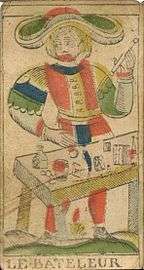 The Magician
The Magician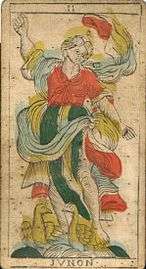 Juno
Juno The Lady
The Lady The Lord
The Lord Jupiter
Jupiter The Lovers
The Lovers The Wagon
The Wagon Justice
Justice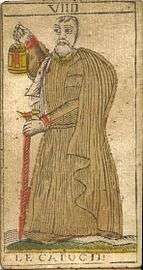 The Hermit
The Hermit The Wheel of Fortune
The Wheel of Fortune Power
Power The Hanged Man
The Hanged Man Death
Death Moderation
Moderation The Devil
The Devil The Tower
The Tower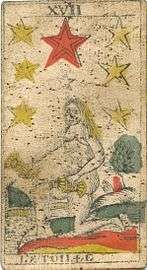 The Star
The Star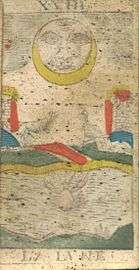 The Moon
The Moon The Sun
The Sun Justice
Justice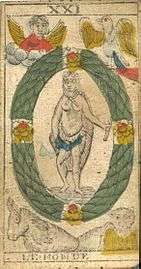 The World
The World
References
- Pattern Sheet 6 - The Tarot de Besançon at the IPCS website. Retrieved 9 Jun 2019.
Literature
- Eckhard Graf: Lexikon des Tarot sowie der Orakel- und Selbsterfahrungsspiele. Nagelschmid, Stuttgart 1991, ISBN 3-927913-03-0.
- Belinda Rodik: Tarot-Lexikon. Grundbegriffe und Schlüsselworte zu Symbolik und Deutung. Schirmer, Darmstadt 2008, ISBN 978-3-89767-612-1, pp 323–346.